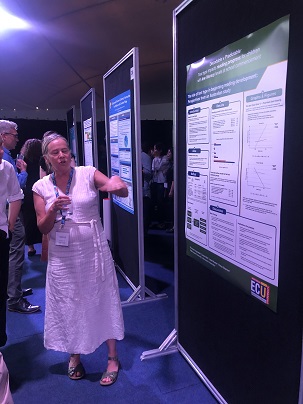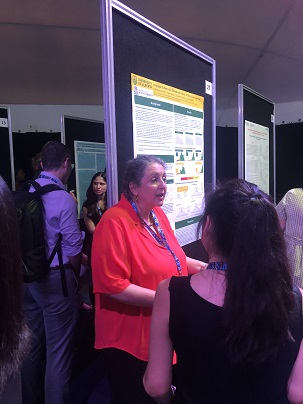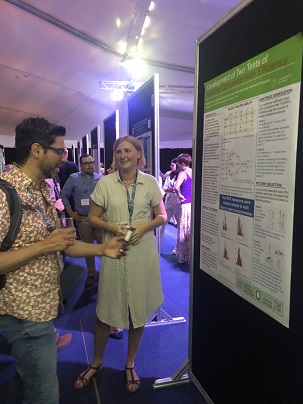Society for the Scientific Study of Reading conference: Day 1
0 RepliesMy head nearly exploded with new learning at the Society for the Scientific Study of Reading Conference in Port Douglas last week. I wasn’t tempted to wag any sessions by beach, pool, sunshine or opportunities to chat, and often wished I could clone myself and go to two or three concurrent sessions.
I’ll try to summarise the most interesting bits, without getting too TL,DR. Any mistakes/misunderstandings in what follows are my fault, let me know if you spot one. I’ll write about one day at a time, or my brain really will explode.
Learning to read syllables
Danish Professor Carsten Elbro (co-author of Understanding and Teaching Reading Comprehension) described research in which adults learnt novel symbols for three phonemes (/m/, /s/ and /ar/, the latter not occurring in Danish). Surprisingly, dyslexic adults couldn’t blend two of these sounds into syllables, though they could say the syllables. Blending is very hard for some people. Perhaps this relates to the way sounds change when they blur together in words (coarticulation).
In Italy, fairly straightforward sound-letter relationships and relatively few possible syllables allow kids to be taught sound-letter relationships, after which most can figure out blending on their own. However, languages like English and Danish have complex relationships between sounds and letters, and greater complexity and number of possible syllables. Prof Elbro studied 200 Danish and Italian children in Grades 1 and 2, and found that learning to read new syllables was something that had a protracted influence on decoding development, especially in Danish. This may present lasting obstacles for learners in blending and retaining (via orthographic mapping) the pronunciations and spellings of syllables, so they can be read instantly in words.
Prof Elbro’s research found that showing kids how to blend by moving letter cards together was a waste of time. The kids who didn’t have this ‘blending support’ did equally well.
Orthographic skeletons
Readers who hear short, novel words create ‘orthographic skeletons‘ for them by thinking about how they’re probably spelt. Esra Ataman of Macquarie University’s Masters thesis research taught 81 adults made-up, spoken (but not written) words with suffixes like ‘vished’, ‘visher’, ‘jafed’ and ‘jafer’. These “inventions of Professor Parsnip” were used in sentences e.g. a ‘visher’ is a toaster-like machine used for shuffling cards. The adults were then asked to read the made-up base words e.g. ‘vish’ (expected spelling) and ‘jayf’ (weird spelling, you’d expect ‘jafe’ or ‘jaif’) and their reaction times were recorded. Weird spellings were read more slowly, suggesting the adults had formed orthographic skeletons for the made-up base words, even though they’d never heard them without suffixes. Whether the trained words had inflectional or derivational suffixes didn’t seem to make much difference.
Morphology meta-analysis
Dr Danielle Colenbrander from the recently-established Australian Centre for the Advancement of Literacy at ACU reported on a meta-analysis of research about teaching children how words are made up of meaningful word parts (morphology). Findings suggested morphology instruction helps kids with word-level reading and spelling, and transfers to the spelling of new words, but doesn’t affect comprehension. Only four of the 27 mostly US/UK studies included in this research studied beginning readers (K-2) so we don’t really know how early to start. Explicit teaching and longer-term intervention seemed to be better than implicit or short-term teaching, but there was great diversity and many gaps in the research, making it hard to know what kind of teaching is most effective, who benefits the most, or draw other conclusions.
Morphemes as islands of regularity
Dr Elisabetta Simone from Macquarie University compared how suffixes work in English and Italian. English has less complicated morphology than Italian, but much more complicated sound-spelling relationships. Her research added suffixes to real and nonsense words, and measured how quickly samples of 60 speakers of each language decided whether they were real words or not. The results suggested that English speakers relied more on morphological processing than the Italian speakers. Perhaps in the crazy chaos of the English writing system, standard spellings of morphemes provide helpful islands of regularity.
A hangover is not an overhang
Jasmine Spencer from Macquarie University spoke about the position of morphemes in written words. Free morphemes (words in their own right) can occupy different positions in longer words: ‘book’ is at the start of ‘bookshelf’ but the end of ‘textbook’. Even when compound words are scrambled e.g. ‘proofweather’ and ‘childrengrand’, they still look like real words. However, prefixes and suffixes are position-dependent. When they’re out of order – ‘ismtru’ or ‘ismsch’ – they look like gibberish. The 90 adults in her research took longer to reject scrambled compound words when their meanings were suggested by the component words (e.g. dreamday) than when they were not (e.g. linedead), and quicker to reject scrambled non-compounds (e.g. shadeday), so semantics plays a role in processing these written words. Subjects also rejected nonwords more slowly when they had real suffixes.
The Word and Affix Model

Dr Lisi Beyersmann from Macquarie University talked about a new model showing word parts being processed separately during reading. This is based on research showing typical readers read complex non-words containing real morphemes more easily than similar looking non-words. Research involving five adults with acquired dyslexia also showed they benefited from the presence of identifiable morphemes when reading nonwords. Even though prefixes come first in words, stems facilitated non-word reading more. This might be because stems tend to have clearer meanings, whereas affixes tend to be more abstract.
Tween/teen processing of morphemes
Leah Zimmermann from the University of Iowa spoke about research examining automatic processing of morphemes in 80 monolingual 12-14 year olds of varying reading ability. Students’ reading accuracy and automaticity (words presented for 90 milliseconds) were both tested on a set of 320 words. Half the words had only one morpheme, and half had two morphemes (stem and derivational suffix). Automaticity was important for fluency and comprehension, but the role of morphological processing was less clear. My notes say that the only variable to contribute unique variance to comprehension was the ability to read syllables, but I can’t find that in the abstract, so I hope it’s correct.
Spelling irregular words
Most English word spellings follow sound (phonological) or word part (morphological) logic, but some don’t. There’s growing interest in how to teach these, for example using ‘spelling pronunciations’ or repeated practice. A/Prof Saskia Kohnen from Macquarie Uni talked about a study of 14 children aged 8-11 who were poor spellers (5th percentile on the Test of Written Spelling) but had other skills in the average range. They did pre-tests, then two and six weeks later wrote out 182 irregular words from the Oxford Word List, to gather two baselines. There wasn’t much natural spelling improvement in between. They then did four weeks of training (direct copying, delayed copying, spelling to dictation) at home on 32 of the words, then did a post-test.
All 14 kids made significant gains on trained words. Eight also significantly improved on untrained words. Words containing only minor errors were more likely to improve, along with words high in frequency and neighbourhood size (with similar sounds/spellings). Improved spelling of untrained words might mean kids were using a different strategy, or improving their ability to represent words in long-term memory.
Lexical richness: the vocabulary of books
The language of books is quite different from the language we use in everyday conversation. Books tend to use more sophisticated words, and unique word types. Reading aloud to children gives them early exposure to this language, or access to greater ‘lexical richness’. Nicola Dawson and colleagues from Oxford University read 180 children aged 4-7 three versions of specially-written stories. One version used a basic vocabulary item (e.g. ‘hungry’) several times, another used several synonyms (e.g. ‘hungry’, ‘starving’, ‘peckish’, ‘famished’), and a third version used the most sophisticated word (e.g. ‘famished’) repeatedly. Children were asked to retell the stories to see which words they used. Children who heard the sophisticated words repeatedly were more likely to use them. Diversity was less important. There was a clear benefit from re-reading the stories. They are still collecting data on retention/use of synonyms.
Executive Functions training
Working memory, attention, cognitive flexibility and inhibitory control – known collectively as Executive Functions – affect all learning. Shani Levy-Shimon from Israel’s Bar-Ilan University studied 72 Hebrew-speaking third grade poor readers, who worked in small groups of 3-4 students, for 35 minutes, three times a week for 16 weeks. 6 teachers each taught 2-3 groups, using either a multicomponent literacy intervention or business as usual. Some of the multicomponent intervention included Executive Functions training. The children receiving the Executive Functions training outperformed the other groups on all measures.
Psychosocial wellbeing
There were quite a few talks about the psychosocial impacts of literacy skill development/failure, but I’d decided to focus on word-level reading and spelling, so missed most of them. However, I did plan to attend a talk by NZ Prof John Everatt about research following two samples of struggling readers in Years 4-6. One group of 57 students received morphology intervention from Speech-Language Pathologists, while a second group of 30 received this intervention from their classroom teacher. Both groups improved not only their vocabulary, morphological awareness, word reading, spelling and reading comprehension, but also their academic self-concept and self-efficacy.
With five talks per session, and no time in between, I was often running between rooms like a madwoman, so must have missed the start of this one, when (I think) A/Prof Alison Arrow of Canterbury Uni, a co-author of the original abstract, explained John couldn’t come, and she’d talk about her PhD research instead. She had studied three groups of about 20 middle school students, who were given morphological intervention – 30 minutes 4 times per week for 10 weeks (40 sessions), or 20-30 minutes across 20 weeks (40 sessions). Their literacy skills improved, with some improvements on psychosocial measures as well.
She also said difficulties in psychosocial development due to literacy difficulties can emerge within the first six weeks of schooling, or even earlier, and can be pervasive and compound as students progress through school. Kids with learning difficulties often blame themselves for failure, but attribute success to external factors. There’s some evidence psychosocial development is very stable, so giving these kids reading success is perhaps the best way to meet their psychosocial needs.
Brain scans and diagnostic terms
Kelly Mahaffy from the University of Connecticut talked about brain scans comparing typical readers and poor decoders with ‘poor comprehenders’. She said the latter group make up about 10% of the population, and have reduced vocabulary, and difficulties with semantic and syntactic processing, inference and comprehension monitoring. In a large sample from the Child Mind Institute Healthy Brain Network Biobank, there were some frontal lobe grey matter differences, but no significant difference in white matter. This suggests executive functions are important in reading comprehension.
After the session I asked her why she didn’t use the internationally-agreed term Developmental Language Disorder instead ‘Poor Comprehenders’. She said there are people who are good at both decoding and language comprehension, but poor at reading comprehension. I raised an eyebrow and said I’d never met one, and she said she’d send me more information. I’ll let you know if it’s interesting.
Poster displays
After lunch each day there were lots of poster displays. I won’t try to summarise them, or the interesting discussions they provoked, but here’s what they looked like:











Leave a Reply